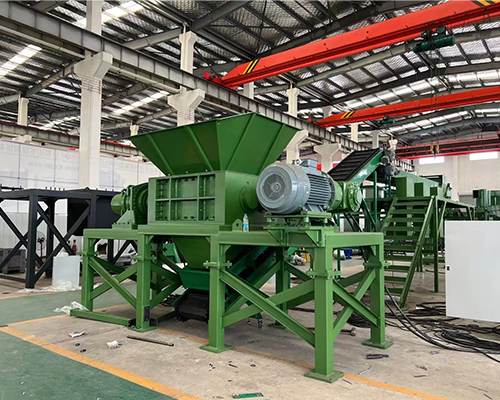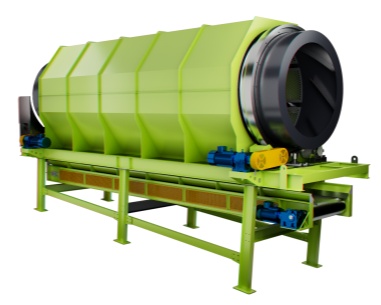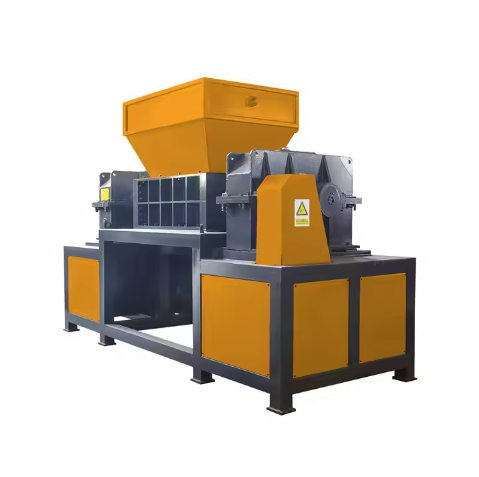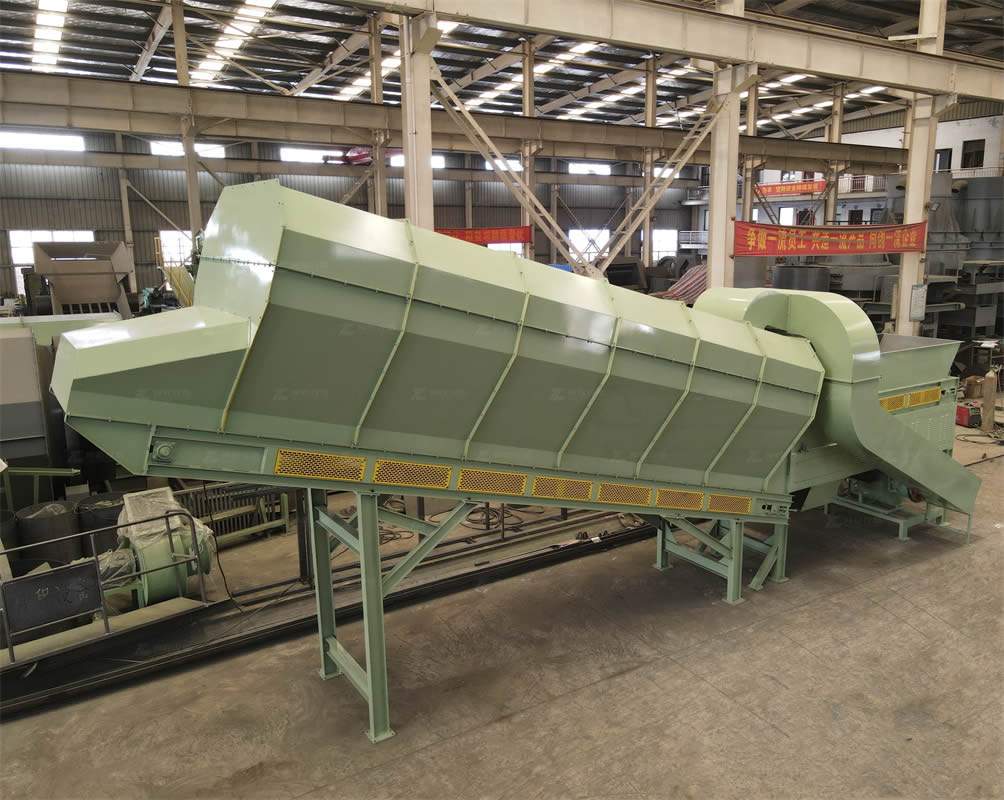Coconut Shell Shredder: Helps Efficient Processing and Comprehensive Utilization of Coconut Shells
Coconut Shell Shredder: Helps Efficient Processing and Comprehensive Utilization of Coconut Shells

Coconut shell shredder is a crushing equipment specially designed for the characteristics of coconut shells. It plays a key role in the coconut processing industry chain and the comprehensive utilization of related resources.
1. Structural Features
1. Feeding system: It is usually equipped with a large-sized and optimized-shaped feeding hopper to facilitate the smooth entry of coconut shells of various sizes. A conveyor belt or a screw propeller is connected under the feeding hopper to stably and evenly transport the coconut shells to the subsequent shredding device to ensure the continuity and stability of the feeding process.
2. Shredding device: This is the core component of the equipment, mainly composed of two knife shafts and blades installed on the knife shafts. The knife shaft is made of high-strength alloy steel and has undergone a special heat treatment process. It has extremely high strength and wear resistance and can withstand the huge torque and impact force generated in the process of shredding coconut shells. The blade is made of high-quality wear-resistant alloy material, and after precision processing and special surface treatment, the blade is sharp and durable. The shape and arrangement of the blades are carefully designed. When the blade shaft rotates, the blades interlace and bite each other, which can fully contact the coconut shell and generate strong shearing force, tearing force and extrusion force, thereby effectively breaking the coconut shell into small pieces.
3. Power system: It consists of a motor and a reducer. The motor provides power for the equipment. Depending on the different equipment models and processing capabilities, the motor power is generally between 15-55kW. The reducer converts the high-speed rotation of the motor into the low-speed and high-torque rotation required by the blade shaft. Through the precise gear transmission ratio design, it ensures that the blade shaft can run at a suitable speed, thereby achieving efficient shredding of the coconut shell.
4. Discharging system: Located at the bottom or side of the equipment, it is usually equipped with components such as a discharging conveyor belt, a discharging scraper or a discharging port. The discharging conveyor belt drives the roller to rotate through the motor, driving the coconut shell fragments on the surface of the conveyor belt to move forward to achieve discharging. The discharging scraper is suitable for scraping the material from the bottom of the equipment. The discharging port allows the coconut shell fragments to fall directly into the collection container or conveying equipment below under the action of gravity. Some discharging systems can also adjust the discharging speed and discharging direction as needed to meet different production needs.
2. Working Principle
The working principle of the coconut shell shredder is based on the coordination of three forces: shearing, tearing and extrusion. When the coconut shell enters the shredding device through the feeding system, the power system drives the knife shaft to rotate at high speed. The blades installed on the knife shaft move accordingly and fully contact the coconut shell.
In this process, the shear force comes into play first. The blades intersect and bite each other like scissors. When the coconut shell enters the gap between the blades, the high-speed rotating blades will exert a strong shear force on the coconut shell, cutting the coconut shell from the surface to form initial cracks and fragments.
As the knife shaft continues to rotate, the cut coconut shell is further affected by the tearing force under the further action of the blade. Due to the special shape and arrangement of the blades and the high-speed rotation of the knife shaft, the coconut shell will be constantly pulled and twisted between the blades. This pulling and twisting force will gradually destroy the fiber structure inside the coconut shell, resulting in a tearing effect. The coconut shell will be further torn from the initial crack to form larger fragments.
In addition to shearing and tearing forces, extrusion forces also play an important role in the shredding process of coconut shells. When the coconut shells are sheared and torn between the blades, the blades will also exert a certain extrusion force on the coconut shells. This extrusion force will compress and destroy the internal structure of the coconut shell more tightly, further promoting the crushing of the coconut shell. Under the action of extrusion force, the coconut shell fragments will become smaller and more uniform.
As the shredding process continues, the coconut shells are gradually broken into small pieces under the combined action of shearing force, tearing force and extrusion force. These small pieces gradually fall to the discharging system under the action of gravity. The discharging system transports the shredded coconut shell fragments to the designated location to complete the shredding process of the coconut shell.
III. Performance advantages
1. Strong processing capacity: After careful design and optimization, the coconut shell shredder has powerful power and efficient shredding device, which can quickly and effectively process a large number of coconut shells. The rotation speed of the cutter shaft and the shear force, tearing force and extrusion force of the blade are accurately calculated and matched, which can crush the coconut shell into the required particle size in a short time, greatly improving the production efficiency and meeting the needs of the coconut processing industry for rapid processing of a large number of coconut shells.
2. Wide adaptability of materials: The equipment fully considers the characteristics of coconut shells, such as hardness, strong toughness and high fiber content. By adopting special blade materials, shapes and arrangements, as well as optimized cutter shaft structure and power system, it can efficiently crush coconut shells without damaging the equipment. In addition, the equipment can also adjust the size and shape of the feed port as needed to meet the feeding requirements of coconut shells of different sizes and shapes. At the same time, for some coconut shells containing impurities (such as sand, soil, etc.), the coconut shell shredder can also effectively process them, and the normal operation and crushing effect of the equipment will not be affected by the presence of impurities.
3. Stable and reliable operation: During the design and manufacturing process, great attention was paid to the stability and reliability of the equipment. Its key components, such as cutter shafts, blades, reducers, motors, etc., are all made of high-quality materials and advanced manufacturing processes. The knife shaft is made of high-strength alloy steel and undergoes a special heat treatment process to make it extremely strong and wear-resistant. It can withstand the huge torque and impact force generated in the process of tearing coconut shells, ensuring that the knife shaft will not deform or damage under long-term, high-load operating conditions. The blade is made of high-quality wear-resistant alloy material, and after precision processing and special surface treatment, the blade is sharp and durable. It can maintain good cutting performance during frequent shearing, tearing and extrusion, reduce blade wear and replacement frequency, and improve the operating stability and reliability of the equipment. The reducer adopts a high-precision gear transmission structure. After strict quality inspection and debugging, it ensures that it has high transmission efficiency, low noise and low vibration. It can smoothly convert the high-speed rotation of the motor into the low-speed and high-torque rotation required by the knife shaft, providing reliable power support for the stable operation of the equipment. The motor uses high-quality, high-efficiency and energy-saving motors with the advantages of high power factor, large starting torque, high operating efficiency, low noise and low vibration. It can provide sufficient power for the equipment and ensure that the equipment can operate stably and reliably under different working conditions.
In addition, the overall structure of the equipment is reasonably designed, and it is welded with high-strength steel plates, which has good rigidity and seismic resistance. The frame of the equipment has been carefully designed and calculated to withstand various forces generated during the operation of the equipment, including gravity, inertia, torque, impact, etc., to ensure that the equipment will not shake, deform or be damaged during operation, and to ensure the stable operation of the equipment. At the same time, the equipment is also equipped with a complete lubrication system and cooling system, which can effectively lubricate and cool the key components of the equipment, reduce the wear and failure rate of the components, and extend the service life of the equipment. The lubrication system adopts an automatic lubrication device, which can automatically and quantitatively supply lubricating oil to the key components of the equipment (such as knife shaft bearings, reducer gears, etc.) according to the operating status and working time of the equipment, ensuring that these components are always in a good lubrication state during operation, reducing friction and wear between components, and improving the service life of components and the operating stability of the equipment. The cooling system uses air cooling or water cooling to effectively dissipate the heat generated by the equipment during operation, ensuring that the key components of the equipment (such as motors, reducers, knife shafts, etc.) operate within the normal operating temperature range, avoiding problems such as component damage and equipment failure caused by excessive temperature, and ensuring the stable operation and long-term reliable use of the equipment.
4. **Easy operation and maintenance**: The design of the equipment fully embodies the humanized concept, making the operation and maintenance of the equipment simple and convenient. In terms of operation, the equipment is equipped with an advanced PLC control system and an intelligent operation interface. The operator can easily start, stop, forward and reverse, and adjust the speed of the equipment through the buttons and touch screen on the operation interface. At the same time, various indicator lights and display screens are also set on the operation interface to display the operating status, parameter information, fault alarm information, etc. of the equipment in real time, so that the operator can understand the operation of the equipment in a timely manner and effectively monitor and manage the equipment. In addition, the equipment is also equipped with a complete operating manual and training materials. By reading the operating manual and training materials, the operator can quickly master the operation methods and precautions of the equipment to ensure the safe and stable operation of the equipment.
In terms of maintenance, the design of the coconut shell shredder fully considers the maintenance convenience of the equipment. The key components of the equipment, such as the knife shaft, blade, reducer, motor, etc., all adopt a modular design concept, making these components easy to install, disassemble and replace. For example, the installation of the knife shaft and the blade adopts a bolt connection method. The operator only needs to use the corresponding tools to loosen or tighten the bolts to easily complete the installation, disassembly and replacement of the knife shaft and the blade. In addition, the equipment is also equipped with a complete lubrication system and cooling system, and the design of these systems adopts a structural form that is easy to maintain and maintain. For example, the oil filter and oil pump of the lubrication system all adopt a modular design concept, making these components easy to clean, replace and repair. At the same time, the equipment is also equipped with a complete maintenance manual and repair manual. By reading the maintenance manual and repair manual, maintenance personnel can quickly master the maintenance methods and repair skills of the equipment, and perform timely and effective maintenance and maintenance of the equipment to ensure the long-term stable operation of the equipment.
IV. Application Fields
1. Biomass Energy Production: In the context of the growing global demand for renewable energy, biomass energy, as a clean and renewable energy source, has received widespread attention. Coconut shells are rich in organic matter such as cellulose and lignin, have a high energy density, and are ideal biomass energy raw materials.
Coconut shell shredders play an important role in the production of biomass energy. It breaks coconut shells into suitable particle sizes for subsequent drying, molding, gasification and other processing. After these treatments, coconut shells can be converted into biomass pellet fuel or biomass gas fuel.
Biomass pellet fuel has the advantages of high calorific value, good combustion performance, low ash content, and low pollution. It can be widely used in industrial boilers, civil heating, catering stoves and other fields, replacing traditional fossil fuels such as coal and fuel oil, reducing pollution to the environment, and achieving sustainable development of energy.
Biomass gas fuel also has the advantages of high calorific value, good combustion performance, and low pollution. It can be widely used in industrial production, civil gas, power generation and other fields, replacing traditional fossil fuels, reducing environmental pollution, and promoting the optimization and upgrading of energy structure.
By converting coconut shells into biomass energy, it can not only effectively solve the problem of coconut shell processing, but also provide rich raw material resources for the production of biomass energy, promote the development of the biomass energy industry, and achieve the coordinated development of economy, society and environment.
2. Activated carbon manufacturing: Activated carbon has strong adsorption properties due to its highly developed pore structure and huge specific surface area. It is widely used in drinking water purification, air purification, sewage treatment, food processing, pharmaceutical chemicals and other fields.
Coconut shells are hard, high in fiber content and well-developed in pore structure. They are high-quality raw materials for making high-performance activated carbon. In the process of activated carbon manufacturing, coconut shell shredders play a key role. It first breaks the coconut shells into small pieces for subsequent pretreatment processes such as screening and cleaning. The pretreated coconut shell pieces are sent to the carbonization furnace for carbonization. During the carbonization process, the organic matter in the coconut shell decomposes and volatilizes at high temperature to form a carbonized product with a certain pore structure.
The carbonized coconut shell carbonized product needs to be further activated to improve the degree of development of its pore structure and specific surface area, thereby enhancing its adsorption performance. Activation treatment usually adopts physical activation method or chemical activation method. The physical activation method is to pass water vapor, carbon dioxide and other gases into the carbonized material at high temperature, so that the carbon atoms on the surface of the carbonized material react with these gases to form a new pore structure. The chemical activation method is to mix the carbonized material with chemical reagents (such as potassium hydroxide, sodium hydroxide, phosphoric acid, etc.) and react at a certain temperature, so that the chemical reagents react with the carbon atoms on the surface of the carbonized material to form a new pore structure.
In the process of activated carbon manufacturing, the performance of the coconut shell shredder directly affects the quality and production efficiency of activated carbon. Therefore, it is very important for activated carbon manufacturing companies to choose an efficient, stable and reliable coconut shell shredder.
3. Horticultural and agricultural applications: In the field of horticulture and agriculture, coconut shells have a variety of uses after proper treatment. Coconut shells have good air permeability, water retention and drainage, and also contain a certain amount of nutrients such as potassium, phosphorus, calcium, etc., which are very suitable for horticultural and agricultural production.
Coconut shell shredder plays an important role in horticultural and agricultural applications. It can crush coconut shells into particles of different sizes to meet different horticultural and agricultural needs. For example, coarser coconut shell particles can be used to pave garden trails and improve soil aeration; medium-sized coconut shell particles can be used to prepare flower culture soil, vegetable seedling substrate, etc., to provide a good growth environment for plants; finer coconut shell particles can be used to make organic fertilizers, soil conditioners, etc., to increase soil fertility, improve soil structure, and promote plant growth.
In summary, the coconut shell shredder provides strong support for the comprehensive utilization of coconut shells in biomass energy production, activated carbon manufacturing, horticulture and agriculture through efficient crushing of coconut shells, and has significant economic, social and environmental benefits.
| Model | 600 | 800 | 1000 | 1200 | 1400 | 1600 | 1800 |
| Motor(kw) | 11*2 | 18.5*2 | 35*2 | 45*2 | 55*2 | 75*2 | 110*2 |
Reducer | P6-P7 | P7-P8 | P8-P10 | P10-P12 | P11-P13 | P12-P16 | P14-P16 |
| Siemens or other motors, planetary reducers or other reducers can be customized according to customer requirements | |||||||
| Rotation Speed | 8-20rmp | 8-20rmp | 8-15rmp | 8-15rmp | 8-15rmp | 8-12rmp | 8-12rmp |
| Blades Diameter | 220-320 | 260-320 | 260-400 | 400-500 | 400-500 | 500 | 500 |
| Blades material | The material of the blades (55sicr, 5crsi, 9crsi, skd11, m6v, h13) can be customizedaccording to the customer's actual usage | ||||||
| Feeding Size | 1200*900mm | 1400*1000mm | 1600*1200mm | 1800*1300mm | 2000*1300mm | 2200*1700mm | 2400*2000mm |
| The size and appearance of the feeding hopper can be customized according to thecustomer's feeding situation | |||||||
| Weight(kg) | 1800 | 2500 | 3700 | 5500 | 7500 | 9500 | 13000 |
-
 Trommel screenTrommel screen, also known as drum screens, are widely used in various industries for sorting and separating materials.Get Quote
Trommel screenTrommel screen, also known as drum screens, are widely used in various industries for sorting and separating materials.Get Quote -
 Crop straw double shaft shreddApplications:Biomass Energy Production: Shredded straw can be used as a feedstock for bioenergy plants to produce electricity or heat.Livestock Feed: Reduced-si...Get Quote
Crop straw double shaft shreddApplications:Biomass Energy Production: Shredded straw can be used as a feedstock for bioenergy plants to produce electricity or heat.Livestock Feed: Reduced-si...Get Quote -
 Zhongcheng Air Drum SeparatorAir drum separators effectively separate lightweight materials (e.g., plastics, paper) from heavier materials (e.g., metals, glass). This high efficiency is cru...Get Quote
Zhongcheng Air Drum SeparatorAir drum separators effectively separate lightweight materials (e.g., plastics, paper) from heavier materials (e.g., metals, glass). This high efficiency is cru...Get Quote
-
2023-01-12Apron FeedersApron Feeder is a conveyor manufactured from steel plates driven by steel chains wearing on steel surfaces. They are a robust design manufactured for durability...
-
2023-01-12Horizontal Semi-Auto Hydraulic BalerSemi automatic balers are used across the logistics, recycling and manufacturing sectors to process large volumes of waste materials such as cardboard, film, pa...
-
2024-05-29Landfill stale garbage screening projectAfter communicating with our domestic customers in Shandong Province, we learned that he needed to dispose of the garbage in the landfill through excavation, sc...
-
2024-06-09Advantages of Using Drum Screening Machines in Waste ManagementUnderstanding the working principle of drum screening machines is essential to appreciate their efficiency and effectiveness in waste management. Operation and ...
-
2024-08-07Efficient Material Separation with Bounce ScreensThe ballistic separator is an important equipment with separation function designed for the sorting of inorganic particles in the coarsely crushed waste.



